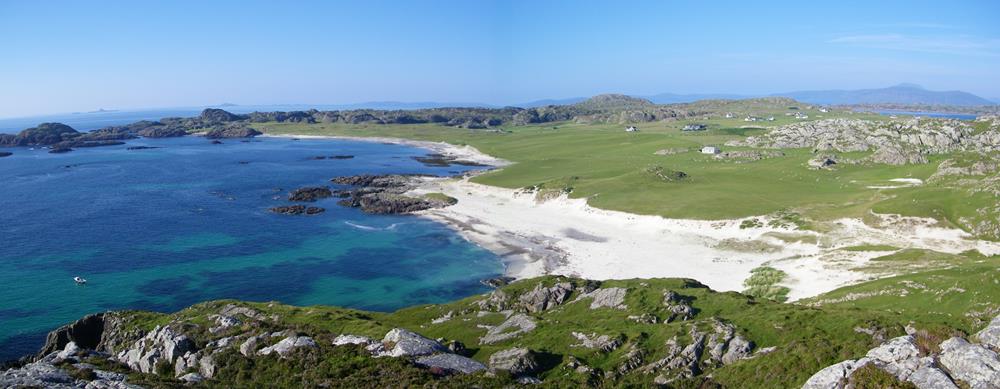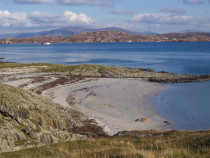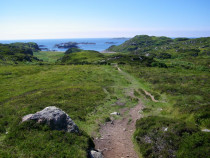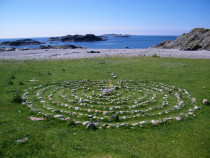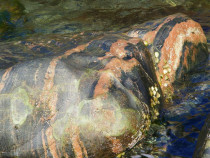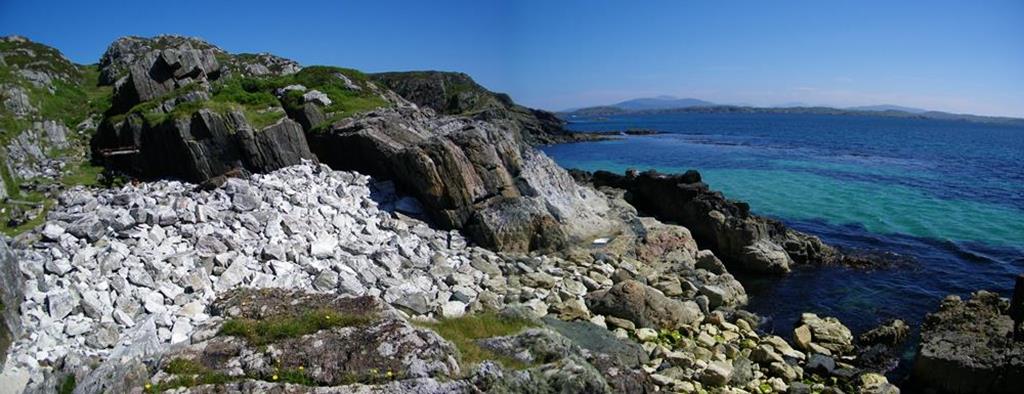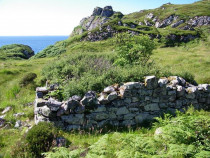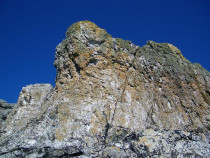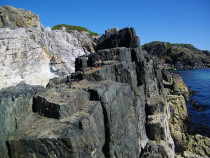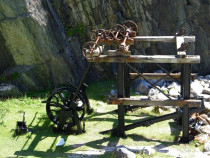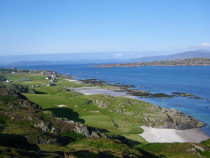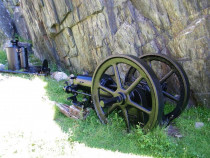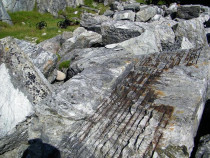Isle of Iona
Machair,The Bay at the Back of the Ocean, Port Ban, Columba's Bay and Marble Quarry
The West Machair Beach and the quaintly named Bay at the Back of the Ocean
I Chalium Cille - The Isle of Columcille - St. Columba
MAP OS EXPLORER 373 Iona, Staffa and The Ross of Mull; OS 341 Iona and Bunessan. Columbas Bay only (excluding quarry ) 3 hours return; approx 8.5 km terrain; minor road, moor and rough shore path
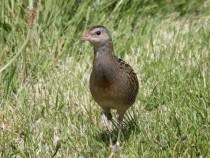
The rare elusive Corncrake on the Isle of Iona strutting its stuff photo by our friend Sheila Robertson
Click on photos to enlarge For information about Iona read more
Visitors are not allowed to take their vehicles onto Iona. Cyclists are welcome and there are many tracks ideal for both cycling and walking. Take a 2 minute walk from Seaview onto the Fionnphort - Iona ferry which runs frequently across the Sound of Iona. Stout walking shoes and warm clothing required on windier days
As you leave the ferry, turn left and follow the metalled road past Martyrs Bay beach, the fire station and Traigh Mor beach. In summer listen out for the monotonous cry of the corncrake in the iris beds between the shore and the road and in the fields. The road follows the shore south for half a mile and then turns right and crosses the island west to the gate at the Machair. Go through the gate onto the short sand based springy turfed grass called machair very fertile and found along Scottish Atlantic coasts.. This is the West Machair where cows and sheep graze. If machair is not grazed wild flowers are abundant and the colours and variety are often amazing.
Traigh Mhor Beach on the road to the west Machairmile and then bends to the west , up a hill across Iona to a gate. Go through the gate and you find yourself on the machair.
This forms the basis of the informal Iona Golf Course which looks onto one of the finest beach views anywhere with the Camus Cuil an Tabibh (Bay at the Back of the Ocean)forming the backdrop. (See main header photo above.)What a lovely quaint name for a spectacularly scenic beach!Turning south on a breezy day with a westerly Atlantic swell you will see a fountain plume of spray rising above the cliffs.This is a natural occurance called "The Spouting Cave" and it can be seen from Dun I two miles away. Now follow the rough track in the machair due south to where the ground rises onto moor. As you approach the hilly moor you will see the track in the hillside to Columbas Bay. Following the track
south over the hill you will come to a small lochan which is to the right of the path. This is Loch Staoineig and used to be the reservoir for Iona. Keeping the lochan on your right descend slowly down the path to Port na Curaich (Port of the Coracle) known as St Columba's Bay. It is said that St Columba landed his coracle here in 563AD after being banned from the Emerald Isle. There are lovely views from here to Soa Island (Sheep Island) and Eilean Musimal (Mouse Island). There is also Eilean na h-Aon Chaorach known locally as 'one sheep island', which was worked by the innkeeper at Iona cottage on the village pier. Columbas Bay is a peaceful lonely spot and must have been an oasis of calm after Columba and his followers had navigated the treacherous waters of South Iona and the Soa sound. The tidal currents all meet here from 3 or 4 directions and around the corner to the west is a channel called "The Boiling Pot", which says it all. John used to have exciting days fishing. for
lobsters here! Columbas Bay is a popular place of pilgrimage and pilgrimsand tourists can often be seen hunting at the low water mark looking for coloured stones and in particular green serpentine pebbles. Best time for this occupation is early spring after the winter Atlantic gales have stirred up the shore stones and pebbles. These pebbles were allegedly piled high by monks as a penance for their sins.On leaving Columba's Bay the easiest way back to Baille Mor village is to retrace your steps. For the more adventurous you can proceed to The Marble Quarry on the south east side of the island but beware this is a more strenuous walk and for the fit more experienced walker only and is described in the section below. If the last ferry leaves in two hours or less return by the outward route and come back to do the quarry walk another time.
Wildlife Watch
Dolphins, seals, otters, cormorant, shag, eider, buzzard, ring plover, lapwing, black backed and herring gulls, rock dove, jackdaw, starlings, linnet, twite, yellowhammer, terns , grey plover, sanderling and godwits.
Last amended 09/05/2021
© 2000-2021
Marble Quarry, Rubha Na Carraig Geire, Iona
OS EXPLORER 373 IONA STAFFA ROSS OF MULL NM 268 217
Marble Quarry Iona
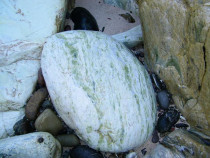 The abandoned quarry lies south of Druim Dhughaill on the south east coast not far from Columba s Bay To find the quarry from Columbas Bay retrace your steps back up onto the machair behind Columbas bay shoreline, following the path you came down for 100 yards approximately . At the point the flattish grass is about to be replaced by a steeper rocky section of the path, approximately 150 yards from the beach, at this point a smaller path veers east up the 3rd gully from the shore. A shallow gully with boulders, heather and grass a rough path winds its way up to a grassy valley running east to the cliffs and shoreline. After about 100 yards in the valley the path goes through a broken wall and bears slightly left,pass an inlet on the shore (on your right) through some rough heather, bear left for 400 yards above a sea cliff and you come to a hollow where there are two old ruined stone
The abandoned quarry lies south of Druim Dhughaill on the south east coast not far from Columba s Bay To find the quarry from Columbas Bay retrace your steps back up onto the machair behind Columbas bay shoreline, following the path you came down for 100 yards approximately . At the point the flattish grass is about to be replaced by a steeper rocky section of the path, approximately 150 yards from the beach, at this point a smaller path veers east up the 3rd gully from the shore. A shallow gully with boulders, heather and grass a rough path winds its way up to a grassy valley running east to the cliffs and shoreline. After about 100 yards in the valley the path goes through a broken wall and bears slightly left,pass an inlet on the shore (on your right) through some rough heather, bear left for 400 yards above a sea cliff and you come to a hollow where there are two old ruined stone
cottages called in gaelic "Tobhta nan Sassunaich" which translates as house of the lowlanders. One of the cottages was living area and the other accommodation for the quarry workers. At the cottages turn right and south south east you will see a deep gully running down to the sea, the quarry machinery and workings are at the bottom of the gully next to the sea. At the quarry you can see cut stone with holes for gunpowder, white cut block waste stone, machinery including remains of a 1880 producer gas engine manufactured by Fielding and Platt, of Gloucester a cutting frame by G Anderson of Arbroath, rail trolley wheels, winch, water tank and iron anchor points in a natural stone pier where boats transported the marble to the mainland.. These items have been given a coat of black paint to stop them rusting further. The quarry is unique and in 1992 was
made a SCHEDULED ANCIENT MONUMENT. The quarry is of national importance because it is the only early
20th century quarry retaining original machinery. Also marble quarrying has been rare in Scotland The quarry was set in the ravine and each side of the ravine is marble and you can see evidence of the working on each side. The marble is white in colour streaked and mottled with yellow-green serpentine. The outcrop was believed to be 7m wide by 100 meters long. The communion table and baptismal font in the IonaAbbey are both carved from Iona Marble quarried on the island. The quarry may date back to the medieval age. The Marquess of Breadalbane
worked the quarry in 1745 , however machinery was first installed about 1790 by the 5th Duke of Argyll,
industrialist William Cadell and Swiss geologist Rudolf Raspe. However it was un economical and closed a few
years later. There was a failed enterprise by The Argyll Quarry Company in the 1800s, who tried to ship on an industrial scale but the remote rocky location proved too hazardous for shipping.It re opened in 1907 but was again closed in 1915. On leaving the marble quarry go back up the the gully you came down earlier to the ruined quarry mans cottages. Keep the cottages to your left and pass them in aapproximately northerly direction for 200 yards up the rough hill track through
another shallow gully to a wooden fence post. At this point you can bear left in a north north west direction along a sheep trail and over a shallow hill and ravine keeping a sheep
fence on your right hand side and meet the Columbas Bay path just south of Loch Staoineig and return to the village the same way that you came.
Alternatively at the wooden post. walk in a roughly north easterly direction on the rough sheep paths picking your way through the odd bog and
rough boulders aiming for the coastal high point in front of you, Druim Dhughaill keeping to the right of a northerly running sheep fence. The views from this summit are fabulous. To the north Iona village, Baille Mor, and Iona Abbey. To the north east the azur blue waters of the Iona sound,The Red granite of the Ross of Mull, the moody Ardmeanach cliffs, and majestic Ben More Mull, to the east and south the rugged Isle of Erraid, Torran rocks with the Paps of Jura and the whisky island Islay in the back drop. On a very clear day looking south and south west you can see Stevensons Dubh Artach Lighthouse and even the north coast of the Emerald Isle where Saint Columba came from in his wee coracle all those centuries ago.
Using Dun I with its cairn, in the distance as a waypoint (the hill beside the abbey) carry on over the sheep trails in a northerly direction, coming to a sheep fence running across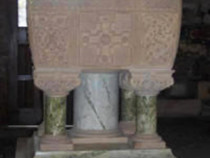
west to east find a metal gate NM276232 which leads to a track that passes Ruanaich farm to the tarred road of the outward walk. For an
alternative scenic route looking over the village and sound of Iona back to the village, cross the tar road and follow the farm track north to Maol farm where you go through the farm with the track bending first right and then gently left down to the village hall behind the nunnery. Head east past the ruined nunnery and Spar shop down the tar road to the center of the village (Baille Mor) and Iona pier.
updated 05/04/2019
Seaview 2000-2019

